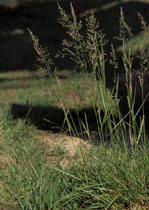|
Late Summer - Time to Seed Your Lawn
Steve Allgeier
Carroll County Master Gardener
Who would of thought that we would be blessed with a very moist year, especially after our recent summers? Of course this weather has brought along it's own set of problems, such as the abundance of weeds, molds, fungi and other plant diseases.
The abuses of past weather conditions have lead to many thin relatively week lawns and as I have mentioned in previous articles these lawns are prime stomping grounds for aggressive weeds. Hopefully, some Carroll County residents have been
eliminating their weeds and are now ready to reclaim their turf.
|

Tall Fescue
Lolium arundinaceum
|
For our area, late summer to early falls is the best time to over seed a lawn or establish new grass. The most dependable and best type of grass for a sunny to partially shaded area, in our region, is turf-type tall fescue.
Turf-type tall fescue is well adapted to the variety of conditions found in the county. It is less prone to disease and insect problems, is drought tolerant, does not form a thatch layer and generally has lower care requirements than many of the
other types of grasses. It is important to make an intelligent choice form among the numerous cultivated varieties (or cultivars) that are available in garden centers. Fortunately, the University of Maryland puts out a publication known as "AM 77 - Turfgrass Cultivar
Recommendations" that can help you with the selection process. It is a research based, Maryland trial performance evaluations of the numerous new turfgrass
cultivars that come out each year. I typically recommend that people review this and take it to the store with them before purchasing, since good seed is not cheep.
In general most lawns will need between 3 - 5 pounds of turf-type tall fescue seed per 1000 square feet to overseed existing lawns and as much as 6 - 8 pounds for establishing new lawns. Before overseeding a weak lawn it is advisable to do a soil
test. If you have used a lawn weed herbicide recently, please check its label for how long you must wait before overseeding or reseeding.
The University has several helpful publications to help you reestablish a vigorous dense lawn. The primary publication is called Lawn Establishment, Renovation, and Overseeding - HG# 102 - this 12-page publication gives a comprehensive look at a very large topic. It deals with everything from different types of seeds to installation tips
and care for the emerging plants.
Read other articles on lawn care & weed control
Read other summer related gardening articles
Read other articles by Steve Allgeier |